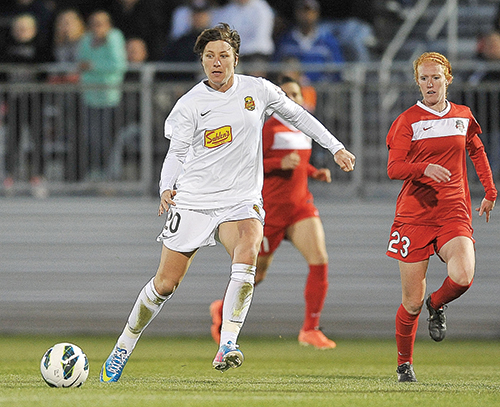Imagine, for a moment, a scenario that could play out in a number of sports. Running up the middle late in a game, a player waits for a pass from a teammate. There is no opponent nearby, and the player finds a pocket in the coverage and settles into space. Suddenly, without a moment to react, a shot to the head leaves the athlete writhing on the ground.
The myth of safety on the field of play

Imagine, for a moment, a scenario that could play out in a number of sports.
Running up the middle late in a game, a player waits for a pass from a teammate. There is no opponent nearby, and the player finds a pocket in the coverage and settles into space. Suddenly, without a moment to react, a shot to the head leaves the athlete writhing on the ground.
Just 30 seconds after being felled, the player rises on wobbly legs. The last five minutes of the contest play out to their resolution, and opponents remark in postgame interviews that the concussed superstar was incoherent in the final moments of the game.
What image first comes to mind? Do you envision a hockey player being leveled in the neutral zone as he pauses to receive the puck? Maybe a slot receiver getting blasted by a linebacker? Along with combat sports like boxing and mixed martial arts, these are likely the first pastimes to be mentioned in a discussion of the risk of concussions and other injuries that can lead to permanent physical damage. But in an age when everyone is getting faster and stronger, no sport is devoid of dangers.
This sequence of events happened less than two weeks ago, but not at the rink or on the gridiron. Instead, they took place on a soccer field in the nation’s capital, in a National Women’s Soccer League match between the Washington Spirit and the Western New York Flash on April 20.
The player was Abby Wambach, second all-time behind Mia Hamm in goals scored for the U.S. women’s national team. Representing her hometown Flash, Wambach was hovering at midfield when she was struck full-force in the face by a teammate’s errant downfield pass in the waning moments before stoppage time—and just minutes after setting up the equalizer in the 1-1 draw.
According to a 2011 Centers for Disease Control report on high school athletics, women’s soccer is second only to football in terms of concussion rates among athletes. Even as the public comes to grips with the suicides of Junior Seau and other former football players and learns more about the dangers of chronic traumatic encephalopathy through the pioneering research being conducted at Boston University, we still tend to think in fairly narrow terms when it comes to what sorts of activities invite the risk for such injuries. Concussive blows, as Wambach learned the hard way, are hardly relegated to collision sports.
High rates of traumatic brain injuries can be found in unexpected places all across the athletic spectrum. It happens in sports like cycling and horse racing, where spills are an inevitable hazard of the occupation. Gymnasts and alpine skiers are always one slip away from a potential trauma. Even in a supposed noncontact sport like basketball, Pau Gasol and Anthony Davis were diagnosed with concussions during the most recent NBA season.
Not every athlete is doomed to suffer the scrambling of his or her brain over the course of a career. But the “citius, altius, fortius” ethos that remains paramount in sports often leaves world-class physical athletes permanently disabled once their playing days are over. Though it’s always exciting to witness a record being broken, it is the athlete who vis left to deal with the consequences of pushing the body beyond its normal limits.
Naturally, there is a simple cost-benefit analysis at work here. Regardless of the sport in which an athlete excels, financial incentives usually win out when weighed against the health risks inherent in the action. Few people are willing to rip up the genetic lottery ticket that can vault a person into a significantly elevated tax bracket.
So we continue to turn our heads from the ugly realities of high-level athletic competition, choosing instead to revel in the highlight of the moment and willfully ignoring that omnipresent fear that the next play could leave somebody crumpled on the turf. But it’s an issue that needs to remain in the discussion, whether we’re talking about football or soccer or the Tour de France.





